
Armour-piercing ammunition (AP) is a type of projectile designed to penetrate armour protection, most often including naval armour, body armour, vehicle armour.

A shell, in a military context, is a projectile whose payload contains an explosive, incendiary, or other chemical filling. Originally it was called a bombshell, but "shell" has come to be unambiguous in a military context. A shell can hold a tracer.
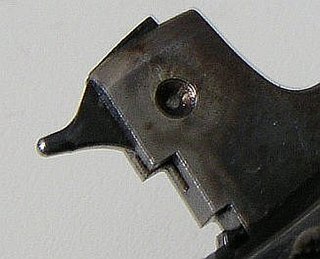
A firing pin or striker is a part of the firing mechanism of a firearm that impacts the primer in the base of a cartridge and causes it to fire. In firearms terminology, a striker is a particular type of firing pin where a compressed spring acts directly on the firing pin to provide the impact force rather than it being struck by a hammer.
This article explains terms used for the British Armed Forces' ordnance (weapons) and ammunition. The terms may have different meanings depending on its usage in another country's military.

The Sturmpistole ("assault-pistol") was an attempt by Germany during World War II to create a multi-purpose weapon which could be used by any infantryman. It consisted of a modified flare gun (Leuchtpistole) which could fire a variety of grenades, including a 600 g shaped charge Panzerwurfkörper 42 which could penetrate 80 mm (3.1 in) of rolled homogeneous armor. The idea was not pursued wholeheartedly, and took second stage to the then current anti-tank rifles and later weapon developments, such as the Panzerfaust recoilless and Panzerschreck rocket.

Ammunition is the material fired, scattered, dropped, or detonated from any weapon or weapon system. Ammunition is both expendable weapons and the component parts of other weapons that create the effect on a target.
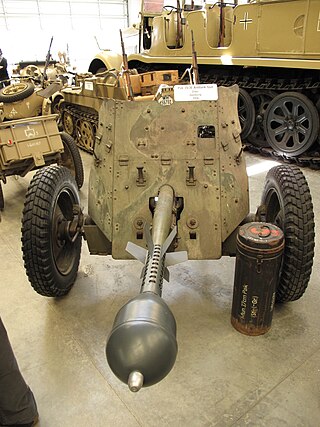
The Stielgranate 41 was a German shaped charge, fin-stabilized shell, used with the 3.7 cm Pak 36 anti-tank gun to give it better anti-tank performance.

The Propaganda-Gewehrgranate was a non-lethal rifle grenade designed to deliver propaganda leaflets that was developed by Germany and used by the Wehrmacht during World War II.
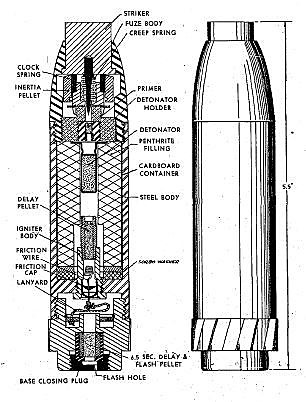
The Gewehr-Sprenggranate was a high-explosive rifle grenade that was developed by Germany and used by the Wehrmacht during World War II.

The Gewehr-Panzergranate was a shaped charge rifle grenade that was developed by Germany and used by the Wehrmacht during World War II.

The Große Gewehr-Panzergranate was a shaped charge rifle grenade that was developed by Germany and used by the Wehrmacht during World War II.

The Gewehr-Granatpatrone 40 or GGP/40 for short was a shaped charge rifle grenade used by German forces during the Second World War. It was originally developed for Luftwaffe Fallschirmjäger units to provide them with a light and portable anti-tank weapon.

The Wurfgranate Patrone 326 was a small grenade that was developed by Germany and used by the Wehrmacht during World War II. The Wurfgranate Patrone 326 was designed to be fired from a Leuchtpistole or flare gun in English.

The Wurfkörper 361 was a grenade that was developed by Germany and used by the Wehrmacht during World War II. The Wurfkörper 361 was designed to be fired from a Leuchtpistole or flare gun in English.

The Leuchtpistole 34 or flare gun in English was introduced into German service before World War II and served throughout World War II.
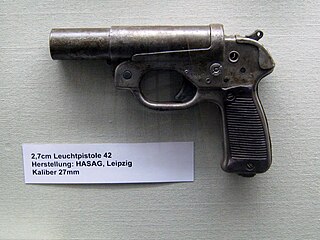
The Leuchtpistole 42 or flare gun in English was introduced into German service in 1943 and served throughout World War II.

The Panzerwurfkörper 42 was a HEAT grenade that was developed by Germany and used by the Wehrmacht during World War II. The Panzerwurfkörper 42 was designed to be fired from a Leuchtpistole or flare gun in English.
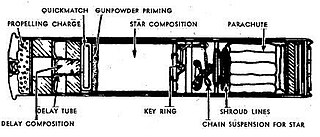
The Fallschirm Leuchtpatrone or "parachute light cartridge" in English was a non-lethal star shell that was developed by Germany and used by the Wehrmacht during World War II. The Fallschirm Leuchtpatrone was designed to be fired from a Kampfpistole flare gun.

The Nebelpatrone or "fog cartridge" in English was a non-lethal smoke grenade that was developed by Germany and used by the Wehrmacht during World War II. The Nebelpatrone was designed to be fired from a Kampfpistole flare gun.

The Kampfpistole or "combat pistol" in English was a flare gun introduced into German service during 1939 and served throughout World War II.

















